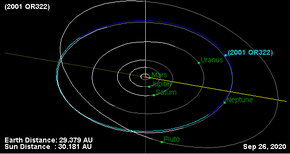 | |
| Discovery[1] | |
|---|---|
| Discovered by | M. W. Buie (DES) |
| Discovery site | Cerro Tololo Obs. |
| Discovery date | 21 August 2001 |
| Designations | |
| (612243) 2001 QR322 | |
| 2001 QR322 | |
| Neptune trojan · L4[2] TNO[3] · distant[1] | |
| Orbital characteristics[3] | |
| Epoch 4 September 2017 (JD 2458000.5) | |
| Uncertainty parameter 3 | |
| Observation arc | 12.26 yr (4,479 days) |
| Aphelion | 30.968 AU |
| Perihelion | 29.262 AU |
| 30.115 AU | |
| Eccentricity | 0.0283 |
| 165.27 yr (60,363 days) | |
| 86.551° | |
| 0° 0m 21.6s / day | |
| Inclination | 1.3250° |
| 151.75° | |
| 151.11° | |
| Physical characteristics | |
| 132 km[4] | |
| 0.058[4] | |
| 22.5[5] | |
| 8.12[3][2] | |
(612243) 2001 QR322, prov. designation: 2001 QR322, is a minor planet and the first Neptune trojan discovered, by American astronomer Marc Buie of the Deep Ecliptic Survey at Cerro Tololo Observatory in Chile on 21 August 2001.[1][6] It orbits ahead of Neptune at its L4 Lagrangian point and measures approximately 132 kilometers (82 miles) in diameter.[2][4]
Other Neptune trojans have been discovered since. A study by American astronomers Scott Sheppard and Chad Trujillo from the Carnegie Institution suggests that Neptune could possibly have twenty times more trojans than Jupiter.[7]
- ^ a b c Cite error: The named reference
MPC-objectwas invoked but never defined (see the help page). - ^ a b c Cite error: The named reference
MPC-NeptuneTrojanswas invoked but never defined (see the help page). - ^ a b c Cite error: The named reference
jpldatawas invoked but never defined (see the help page). - ^ a b c Cite error: The named reference
johnstonsarchive-TNO-listwas invoked but never defined (see the help page). - ^ Cite error: The named reference
Planetary-Societywas invoked but never defined (see the help page). - ^ Cite error: The named reference
Buiewas invoked but never defined (see the help page). - ^ Cite error: The named reference
Space.comwas invoked but never defined (see the help page).